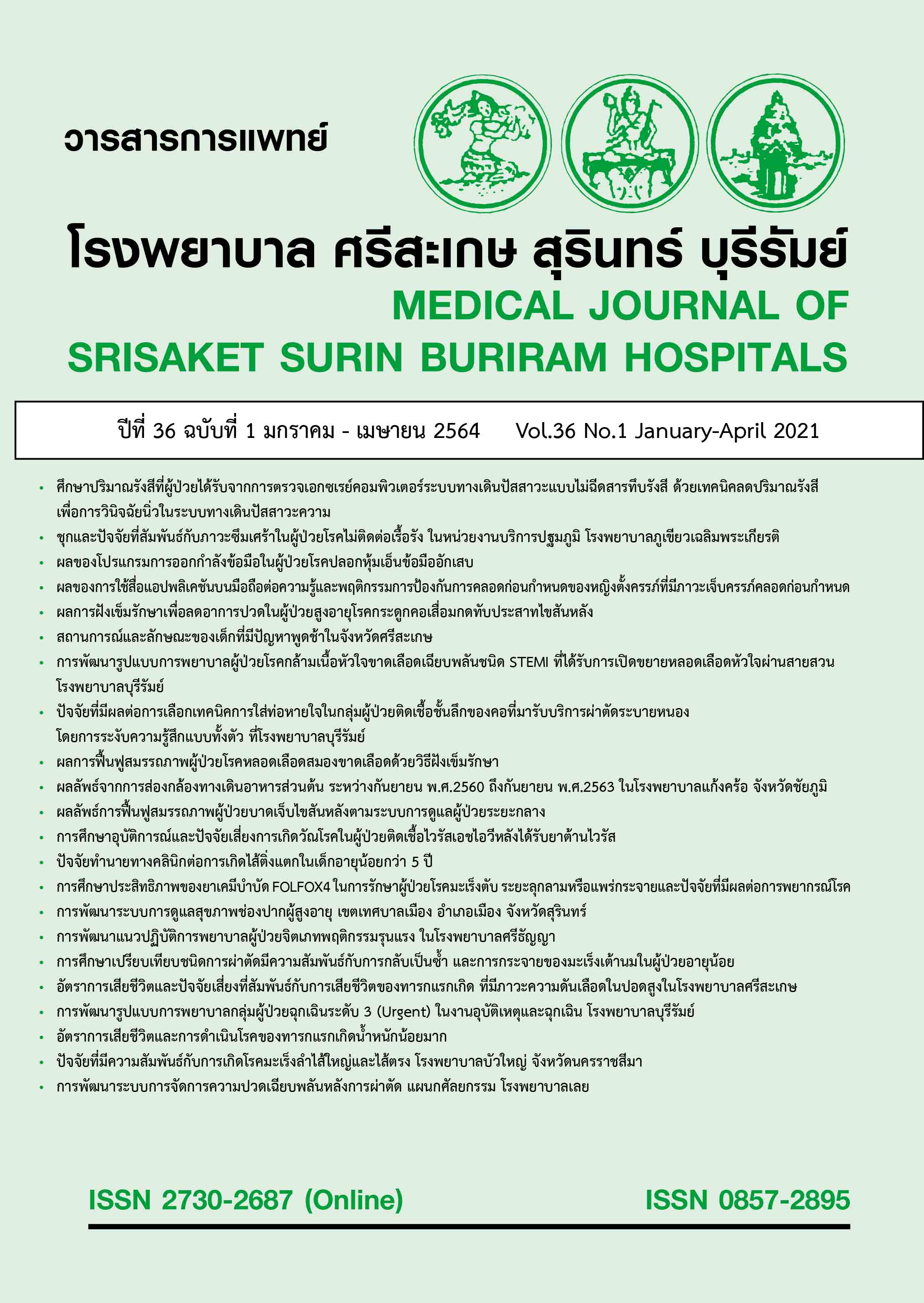ปัจจัยที่มีความสัมพันธ์กับการเกิดโรคมะเร็งลำไส้ใหญ่และไส้ตรง โรงพยาบาลบัวใหญ่ จังหวัดนครราชสีมา
Main Article Content
บทคัดย่อ
หลักการและเหตุผล: โรคมะเร็งลำไส้ใหญ่เเละไส้ตรงเป็น 1 ใน 5 ของมะเร็งที่พบมากที่สุดทั้งเพศชายและเพศหญิงนอกจากเป็นสาเหตุด้านพันธุกรรม ยังมาจากพฤติกรรมและวิถีชีวิต งานวิจัยนี้จัดทำขึ้นเพื่อศึกษาปัจจัยที่มีความสัมพันธ์กับการเกิดโรคมะเร็งลำไส้ใหญ่และไส้ตรง โรงพยาบาลบัวใหญ่ จังหวัดนครราชสีมา
วิธีการศึกษา: งานวิจัยภาคตัดขวาง เก็บข้อมูลจากฐานข้อมูลโรงพยาบาลบัวใหญ่ ระหว่าง เดือน กรกฎาคม พ.ศ.2561 ถึง เดือน ธันวาคม พ.ศ.2563 จำนวนทั้งหมด 101 คน มาวิเคราะห์หาปัจจัยที่มีความสัมพันธ์กับการเกิดโรคมะเร็งลำไส้ใหญ่และไส้ตรง ได้แก่ เพศ อายุ ประวัติโรคมะเร็งลำไส้ใหญ่และไส้ตรงในครอบครัว ประวัติอาการผิดปกติในระบบทางเดินอาหาร ดัชนีมวลกาย โรคเบาหวาน โรคความดันโลหิตสูงประวัติการดื่มสุรา และประวัติการสูบบุหรี่ โดยใช้สถิติเชิงวิเคราะห์
ผลการศึกษา: จากการนำข้อมูลมาวิเคราะห์หาปัจจัยที่มีความสัมพันธ์กับการเกิดมะเร็งลำไส้ใหญ่และไส้ตรง พบว่าเพศชายมีโอกาสเกิดโรคมะเร็งลำไส้ใหญ่และไส้ตรงคิดเป็น 2.3 เท่าของเพศหญิงปัจจัยอายุพบว่าช่วงอายุ 60-79 ปี มีโอกาสเกิดโรคมะเร็งลำไส้ใหญ่และไส้ตรงคิดเป็น 0.3เท่าของช่วงอายุอื่นๆ และพบว่าผู้ที่มีประวัติอาการผิดปกติในระบบทางเดินอาหาร มีโอกาสเกิดโรคมะเร็งลำไส้ใหญ่และไส้ตรงคิดเป็น 4.6เท่าของผู้ที่ไม่มีประวัติอาการผิดปกติในระบบทางเดินอาหาร
สรุปผลการศึกษา: เพศ อายุ และประวัติอาการผิดปกติในระบบทางเดินอาหาร เป็นปัจจัยที่มีความสัมพันธ์กับการเกิดโรคมะเร็งลำไส้ใหญ่และไส้ตรง อย่างมีนัยสำคัญทางสถิติที่ค่า p-value < 0.05
คำสำคัญ: มะเร็งลำไส้ใหญ่และไส้ตรง , ความชุก , ปัจจัยเสี่ยง , การส่องกล้องลำไส้ใหญ่
Article Details
เอกสารอ้างอิง
Bray F, Ferlay J, Soerjomataram I, Siegel RL, Torre LA, Jemal A. Global cancer statistics 2018: GLOBOCAN estimates of incidence and mortality worldwide for 36 cancers in 185 countries. CA Cancer J Clin 2018;68(6):394-424. doi: 10.3322/caac.21492.
World Health Organization. GLOBOCAN Estimate Cancer Incidence Mortality and prevalence worldwide in 2012. [internet] . [cite 2020 Aug 12]. Available from : URL:http://globocan.iarc.fr/ Default.aspx
สถาบันมะเร็งแห่งชาติ กรมการแพทย์ กระทรวงสาธารณสุข. ทะเบียนมะเร็งระดับโรงพยาบาล พ.ศ.2557 [internet]. 2016. [cite 2020 Aug 15]. Available from:URL: http://www.nci.go.th/th/File_download/Nci%20Cancer%20Registry/HOSPITAL-BASED%202014.pdf.
Levin B, Lieberman DA, McFarland B, Smith RA, Brooks D, Andrews KS, et al. Screening and surveillance for the early detection of colorectal cancer and adenomatous polyps, 2008: a joint guideline from the American Cancer Society, the US Multi-Society Task Force on Colorectal Cancer, and the American College of Radiology. CA Cancer J Clin 2008;58(3):130-60. doi: 10.3322/CA.2007.0018.
Elsafi SH, Alqahtani NI, Zakary NY, Al Zahrani EM. The sensitivity, specificity, predictive values, and likelihood ratios of fecal occult blood test for the detection of colorectal cancer in hospital settings. Clin Exp Gastroenterol 2015;8:279-84. doi: 10.2147/CEG.S86419.
Issa IA, Noureddine M. Colorectal cancer screening: An updated review of the available options. World J Gastroenterol 2017;23(28):5086-96. doi: 10.3748/wjg.v23.i28.5086.
Martinelli M, Scapoli L, Cura F, Rodia MT, Ugolini G, Montroni I, et al. Colorectal cancer susceptibility: apparent gender-related modulation by ABCB1 gene polymorphisms. J Biomed Sci 2014;21(1):89. doi: 10.1186/s12929-014-0089-8.
Nebbia M, Yassin NA, Spinelli A. Colorectal Cancer in Inflammatory Bowel Disease. Clin Colon Rectal Surg 2020;33(5):305-17. doi: 10.1055/s-0040-1713748.
Bardou M, Barkun AN, Martel M. Obesity and colorectal cancer. Gut 2013;62(6):933-47. doi: 10.1136/gutjnl-2013-304701.
Botteri E, Iodice S, Bagnardi V, Raimondi S, Lowenfels AB, Maisonneuve P. Smoking and colorectal cancer: a meta-analysis. JAMA 2008;300(23):2765-78. doi: 10.1001/jama.2008.839.
Naing C, Lai PK, Mak JW. Immediately modifiable risk factors attributable to colorectal cancer in Malaysia. BMC Public Health 2017;17(1):637. doi: 10.1186/s12889-017-4650-8.
Liu Y, Ding WB, Yan C, Bao H, Li K, Wang C. Risk factors of colorectal cancer and its clinical epidemiological study. Biomed Res 2017;28:9871-4.
Otani T, Iwasaki M, Ishihara J, Sasazuki S, Inoue M, Tsugane S, et al. Dietary fiber intake and subsequent risk of colorectal cancer: the Japan Public Health Center-based prospective study. Int J Cancer 2006;119(6):1475-80. doi: 10.1002/ijc.22007.
ธิติ ญานปรีชาเศรษฐ. พฤติกรรมเนือยนิ่งเพิ่มปัจจัยเสี่ยงต่อการพัฒนาของโรคมะเร็ง. วารสาร Veridian E Journal ฯ สาขาวิทยาศาสตร์และเทคโนโลยี 2561;5(4):1-15.
Lee SY, Shin A, Kim BC, Lee JH, Han KS, Hong CW, et al. Association between family history of malignant neoplasm with colorectal adenomatous polyp in 40s aged relative person. Cancer Epidemiol 2014;38(5):623-7. doi: 10.1016/j.canep.2014.06.005.


